

Mystery human species emerges from Denisovan genome - life - 19 November 2013. The story of human evolution just got even more bizarre.
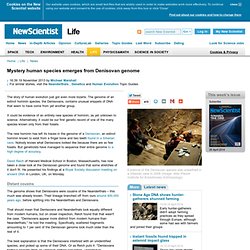
The genome of an extinct hominin species, the Denisovans, contains unusual snippets of DNA that seem to have come from yet another group. It could be evidence of an entirely new species of hominin, as yet unknown to science. Alternatively, it could be our first genetic record of one of the many species known only from their fossils. The new hominin has left its traces in the genome of a Denisovan, an extinct hominin known to exist from a finger bone and two teeth found in a Siberian cave.
Nobody knows what Denisovans looked like because there are so few fossils. David Reich of Harvard Medical School in Boston, Massachusetts, has now taken a close look at the Denisovan genome and found that some stretches of it don't fit. Distant cousins. Denisovan Hominins Interbred With An Unknown Early Human Species, New DNA Analysis Shows. Nature Published on November 22nd, 2013 | by Michael Ricciardi The human family tree just got a little more crowded.
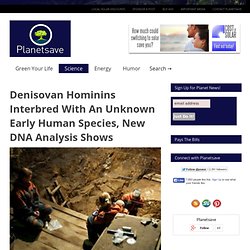
A recent DNA analysis of the Denisovan (Denisova hominins) genome has revealed the presence of unusual genetic sequences not found in Neanderthal or any other known early hominin species — indicating the possible existence of a new unknown ancestor in the human family tree. In 2008, anthropologists excavating a cave in the Altai Mountains of Siberia uncovered two teeth and a finger bone from some type of hominin (i.e., a member of the human evolutionary family) which were dated to 41,000 years ago (ya). Thanks to the cold climate, enough DNA was preserved in these fossils for scientists to sequence most of the genome with a high degree of accuracy. Although there have been no reconstructions of a typical Denisovan (as so few fossils have been found), genetic comparisons showed that they were more closely related (“cousins”) to Neanderthals than to early Homo sapiens. Kambiz Kamrani.
Why do some populations have increased incidences of chronic disease?
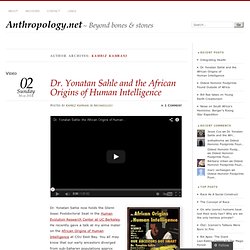
Why do blacks have hypertension more than whites? Why does a Mexican have 2.72 more the risk of having Type 2 Diabetes compared to a non-Hispanic person? A new paper published in Nature yesterday outlines a particularly interesting finding about rhetorical questions about metabolic disease… One that I’ll digest in this post. David Altshuler and his colleagues conducted a GWAS comparing 8,214 Mexicans and other Latin Americans. They specifically had 3,848 people with type 2 diabetes and 4,366 non-diabetic controls. Graphical depictions of SLC16A11 haplotypes constructed from the synonymous and four missense SNPs associated to type 2 diabetes, with haplotype frequencies derived from the 1000 Genomes Project and SIGMA samples. American Indians, Neanderthals and Denisovans: Insights from PCA Views. Dienekes posted a SNP PCA showing the relative position of a sample of modern human populations from the Harvard HGDP along the axes formed by Chimpanzees, Denisovans and Neanderthals.
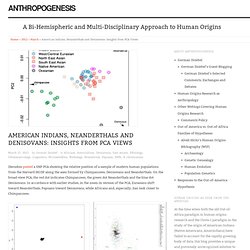
On the broad-view PCA, the red dot indicates Chimpanzees, the green dot Neanderthals and the blue dot Denisovans. In accordance with earlier studies, in the zoom-in version of the PCA, Eurasians shift toward Neanderthals, Papuans toward Denisovans, while Africans and, especially, San look closer to Chimpanzees. Among Eurasians, Lahu and Naxi, two Sino-Tibetan populations from China, are the closest to Neanderthals. This is, by itself, is surprising, as Neanderthals must have had more extensive contact with Europeans, not East Asians.
American Indians again are not represented in the sample. Where the Harvard HGDP sample failed, Skoglund & Jakobsson’s sample encompassing HapMap 3, Chicago HGDP and Finnish HapMap data identified the position of American Indians in PC1 and PC2. What Was Politics to the Denisovan? Massive Neandertal & Denisovan introgression - Gene Expression. Welcome. CARTA: The Genetics of Humanness: Ed Green - The Neanderthal and Denisovan Genomes. Modern humans may have interbred with Neanderthals and Denisovans. Modern humans may have interbred with Neanderthals and Denisovans. Figure 4 : Learning about human population history from ancient and modern genomes : Nature Reviews Genetics. A map illustrating the dispersal of modern humans from Africa about 50,000 years ago, followed by admixture with Neanderthals in the ancestry of all non-Africans, followed by admixture with Denisovans in the ancestry of New Guineans.
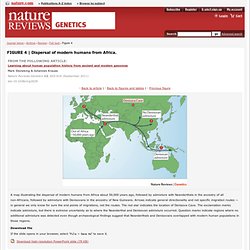
Arrows indicate general directionality and not specific migration routes — in general we only know for sure the end points of migrations, not the routes. The red star indicates the location of Denisova Cave. The exclamation marks indicate admixture, but there is extreme uncertainty as to where the Neanderthal and Denisovan admixture occurred. Question marks indicate regions where no additional admixture was detected even though archaeological findings suggest that Neanderthals and Denisovans overlapped with modern human populations in those regions.
Download file If the slide opens in your browser, select "File > Save As" to save it. Download high-resolution Power Point slide (79 KB) New DNA Analysis Shows Ancient Humans Interbred with Denisovans. Tens of thousands of years ago modern humans crossed paths with the group of hominins known as the Neandertals.
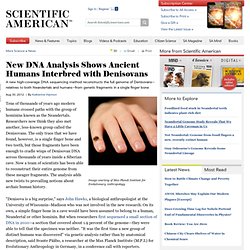
Researchers now think they also met another, less-known group called the Denisovans. The only trace that we have found, however, is a single finger bone and two teeth, but those fragments have been enough to cradle wisps of Denisovan DNA across thousands of years inside a Siberian cave. Now a team of scientists has been able to reconstruct their entire genome from these meager fragments. The analysis adds new twists to prevailing notions about archaic human history. "Denisova is a big surprise," says John Hawks, a biological anthropologist at the University of Wisconsin–Madison who was not involved in the new research. Now Pääbo and his colleagues have devised a new method of genetic analysis that allowed them to reconstruct the entire Denisovan genome with nearly all of the genome sequenced approximately 30 times over akin to what we can do for modern humans.